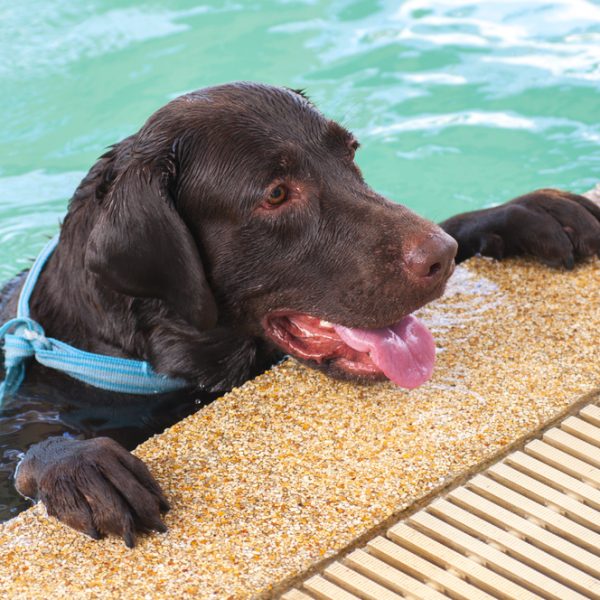How to Develop a Doggie Exercise Program to Keep You and Your Pooch Healthy
 Having a dog is good for you. Aside from the emotional benefits and increases in overall wellbeing, dog owners also tend to benefit from more exercise. Essentially, a doggie exercise program helps keep you and your pooch healthy.
Having a dog is good for you. Aside from the emotional benefits and increases in overall wellbeing, dog owners also tend to benefit from more exercise. Essentially, a doggie exercise program helps keep you and your pooch healthy.
A study from the University of Michigan that found dog owners are more likely to reach their fitness goals than those without dogs and that dog owners are 34 percent more likely to get in 150 minutes of walking per week than non-dog owners. Walking with a dog leads to a 28 percent increase in walking speed, as well, the study states.
You know that simply walking your dog is a great thing to do, health-wise, for both of you, and that play is important, too. But, is helping your dog get the right amount and type of exercise really such a no-brainer?
It’s important to give some thought to your dog’s exercise routine because, in addition to helping raise a dog’s spirits and eliminate behavior problems, exercise prevents chronic health conditions such as arthritis, heart disease, and obesity that come from being sedentary.
Here are some tips on getting your dog to have the right amount of exercise and creating the perfect doggie exercise for their needs:
How much exercise does your pup need?
Whether your dog is a puppy or an old-timer, make sure you consult your vet before you make any changes to their exercise routine. Puppies finish growing at different rates and too much strenuous or high-impact exercise too early can damage their bones and joints that are still developing. Senior dogs, especially those suffering from joint pain or arthritis, will need some extra consideration when it comes to exercise and activity.
A daily walk is important, but most dogs also need daily aerobic—more intense—exercise. Swimming, running, jumping, playing frisbee or fetch, and more all fit the bill for this. Again, if your puppy is still growing, make sure you work with your vet to determine the right amount and intensity of exercise for them.
Different Breeds Have Different Exercise Needs
Dog breeds will vary in the amount of activity they need to be happy and healthy. They’ll also vary in how much they can handle, even when they are fully-grown. And, each dog breed will have its quirks that can affect their exercise needs and abilities.
Toy breeds are prone to obesity. But, the good news is that it’s easy to make sure they get plenty of exercise with daily walks and indoor or outdoor playtime. Because of their small size, these dogs can tire out easily even if they are energetic. Having a few bouts of activity throughout the day can help these small dogs get enough exercise without overexerting them.
Pugs, Bulldogs, and other Brachycephalic breeds, because of their compressed noses, are at risk of shortness of breath and overheating. For these types of breeds, keep exercise light. Depending on the dog, these breeds can handle some strenuous exercise in the right conditions as long as they are given breaks and time to recover. Short bursts of activity throughout the day tend to be best for these dogs.
Terriers have lots of energy to burn and will want at least an hour of exercise each day, while sighthounds like “interval training” in short bursts of activity. Herding dogs and other high-energy working dogs will want at least two sessions of exercise per day of up to two hours each.
Every breed is different and every dog is different. Your vet will be able to help you determine what’s right for your dog. Plus, they’ll be able to provide some recommendations for specific activities too.
How to Create a Doggie Workout
If walking and playing “catch” with a Frisbee aren’t enough, or if you’d like to give your pup some indoor exercise, there are lots of ways to devise a workout.
In the yard or the living room, you can try creating a DIY obstacle course for your dog. If you’re inside, make “jumps” with cardboard boxes, broomsticks, or other items. Just make sure you keep them at or below your pooch’s elbow for safety.
Try taking your dog to the dog park, and you’ll be able to watch them make up their own games with friends! You can also make exercise more fun for both of you by exploring new spots to go for walks or hikes.
Even varying your normal route through the neighborhood can be exciting for your pooch. You can also engage your dog’s brain with games like “hide and seek” too.
These are just a few things to keep in mind when you’re creating a doggie exercise program to keep both of you healthy. Just make sure you talk to your vet before you start anything new and don’t be afraid to ask questions – your vet can be a great resource with a ton of fantastic tips and recommendations!
